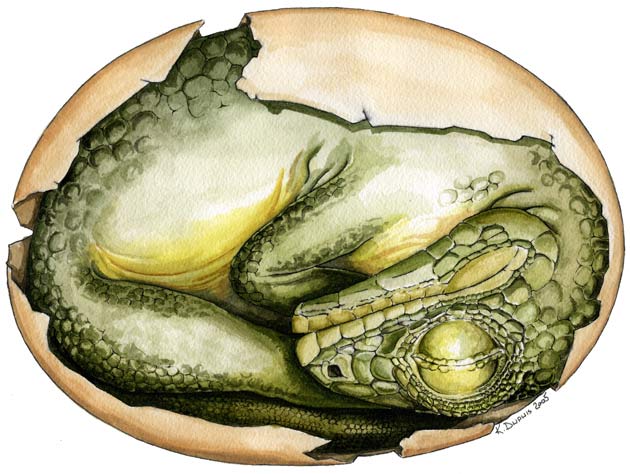Dinosaur Embryos Reveal 'Ridiculous' Proportions

The oldest fossilized dinosaur embryos ever found reveal how the creatures grew from tiny hatchlings to become such giant land beasts.
The embryos, including one that was ready to hatch before being frozen in time, had no teeth. That is further evidence that at least some dinosaurs must have tended their young, scientists said today.
The embryos are 190 million years, dating from the beginning of the Jurassic Period.
"Most dinosaur embryos are from the Cretaceous period (146 to 65 millions years ago)," said biologist Robert Reisz of the University of Toronto at Mississauga. "The work on the embryo, its identification, and the fact we can see the detailed anatomy of the earliest known dinosaur embryo is extremely exciting."
'Ridiculous' proportions
The dinosaur is called Massospondylus. It was common in what is now South Africa.
A typical adult Massospondylus was 16 feet (5 meters) long.
Sign up for the Live Science daily newsletter now
Get the world’s most fascinating discoveries delivered straight to your inbox.
An analysis of the embryos suggests they were born walking on four legs with short tails, long forelimbs and big heads. To morph into their adult shape -- walking on two legs with long tails, short forelimbs and small heads -- their various features must have grown at different rates.
"The proportions are just ridiculous," Reisz said.
There are no other examples of such well preserved embryos combined with adult skeletons among dinosaurs, Reisz said.
The lack of embryonic teeth points to hatchlings that could not possibly have fended for themselves.
"These embryos, which were clearly ready to hatch, had overall awkward body proportions and no mechanism for feeding themselves, which suggest they required parental care," said Reisz, who led the investigation. "If this interpretation is correct, we have here the oldest known indication of parental care in the fossil record."
More impications
The embryos were found in 1978 but only recently have they been exposed from the rock in which they were embedded. The results of the study are detailed in the July 29 issue of the journal Science.
The fossils are in fact the oldest examples of terrestrial vertebrate embryos.
The research indicates how larger dinosaurs later in the fossil record might have come about.
Massospondylus was a prosauropod. The group is thought to have later evolved to include giant sauropods that walked on four legs, including the gargantuan Seismosaurus.
Scientists once thought the group walked only on two legs, then simply dropped to four when they evolved into heavier beasts. But the new findings may challenge that assumption by showing that even prosauropods had some tendency to walk on four legs.
"Because the embryo of Massospondylus looks like a tiny sauropod with massive limbs and a quadrupedal gait," Reisz and his colleagues speculate that "the sauropod's gait probably evolved" by a process in which features present in an embryo and juvenile gradually become predominant in adults later in the evolutionary timeline.
"This would be significant because it means we might have to re-evaluate the origin of many features in sauropod skeletons we assumed had to do with weight support," said Western Illinois University researcher Matthew Bonnan in a separate article in the journal.
- Birds of Prey: See Today's Dinosaurs
- Avian Ancestors: Dinosaurs that Learned to Fly
Robert is an independent health and science journalist and writer based in Phoenix, Arizona. He is a former editor-in-chief of Live Science with over 20 years of experience as a reporter and editor. He has worked on websites such as Space.com and Tom's Guide, and is a contributor on Medium, covering how we age and how to optimize the mind and body through time. He has a journalism degree from Humboldt State University in California.










